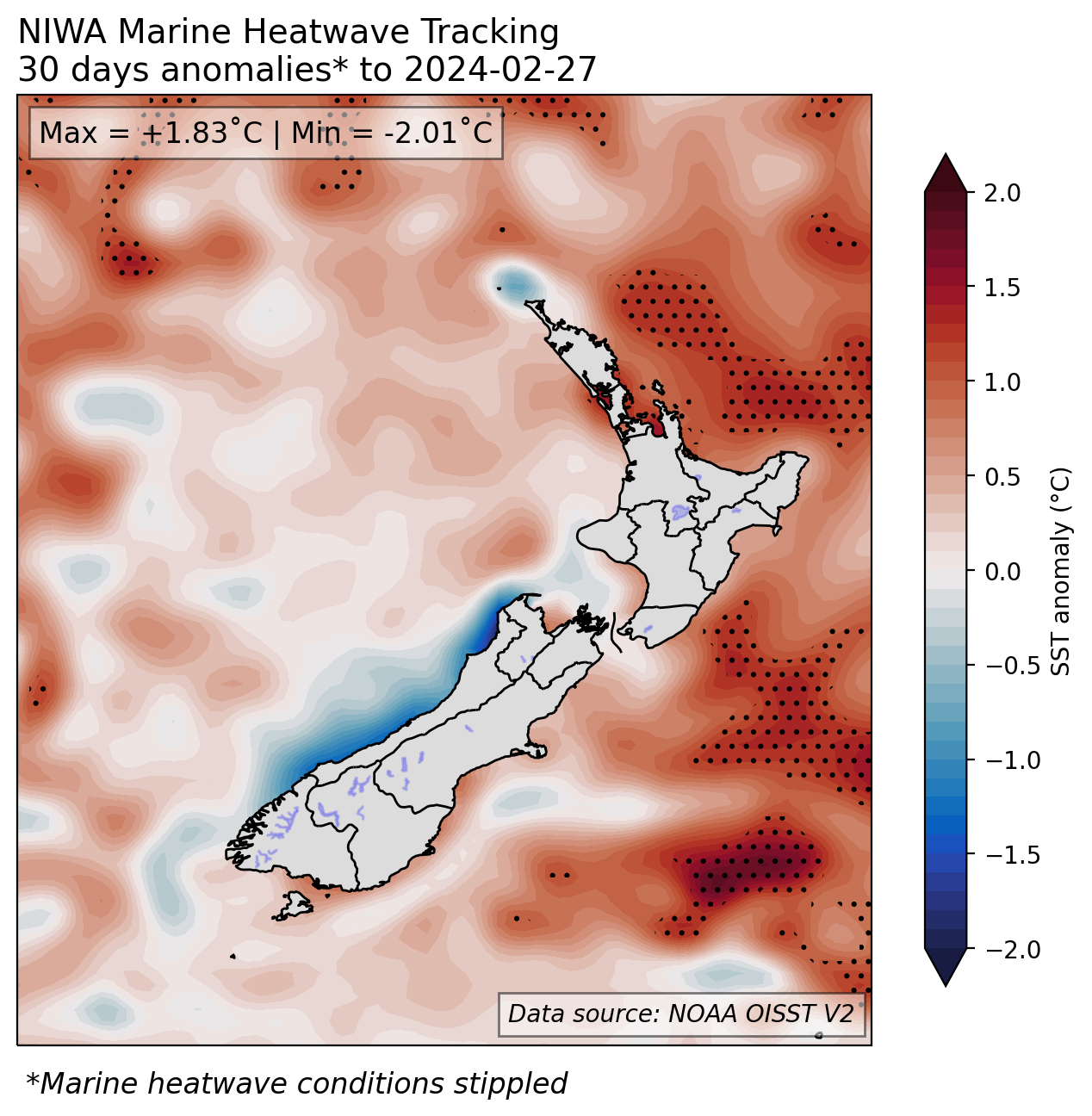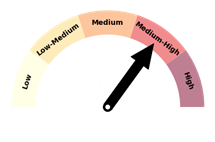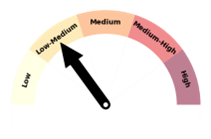Outlook Summary
- El Niño is expected to ease to ENSO neutral by the end of autumn. The autumn season is favoured to have more northwesterly winds than normal around Aotearoa/New Zealand.
- During March, there is a chance for heavy rainfall during the first week and again in the second half of the month. The first period will favour western areas of both islands while the second may favour the North Island and northern South Island.
- For the autumn season as a whole, rainfall is about equally likely to be near normal or below normal in the north of the North Island, near normal or above normal in the west of the South Island, and near normal in all remaining regions.
- Although seasonal rainfall may return to normal for several regions, including those that experienced below normal rainfall in recent months, rainfall events will likely occur irregularly through autumn. Monitor NIWA35 for updates.
- Autumn temperatures are expected to be above average in the North Island and east of the South Island. Average or above average temperatures are about equally likely elsewhere. Despite an early March cold spell, southerly winds are expected to be infrequent.
- Autumn wind strength is likely to be above normal in the South Island and lower North Island, with a strong wind event forecast for the first week of March.
- In the South Pacific, the chance for tropical cyclone activity is expected to increase during mid-March. While New Zealand has a normal-reduced risk for ex-tropical cyclones this season, an increased level of awareness around tropical cyclone activity is encouraged.
- Coastal sea surface temperatures (SSTs) ranged from 0.32˚C below average to 0.63˚C above average during February. Marine heatwaves eased during February, aside from in parts of the northern and eastern North Island.
- Soil moisture levels are about equally likely to be near normal or below normal in the west and east of the North Island, most likely to be near normal in the west of the South Island, and most likely to be below normal in all remaining regions.
- River flows are most likely to be below normal in the east of the South Island, equally likely to be near normal or above normal in the west of the South Island, and about equally likely to be near normal or below normal in all remaining regions.
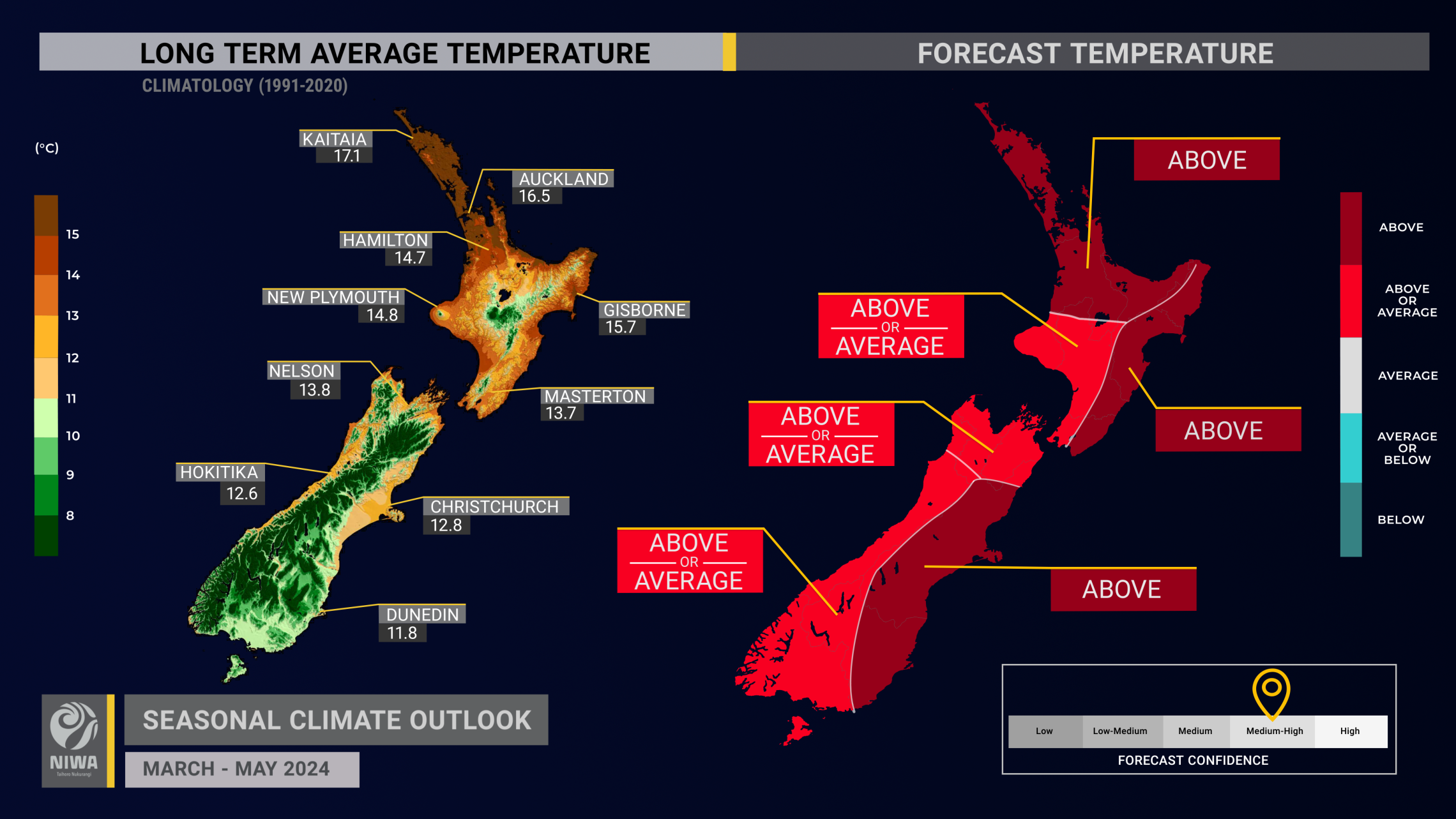
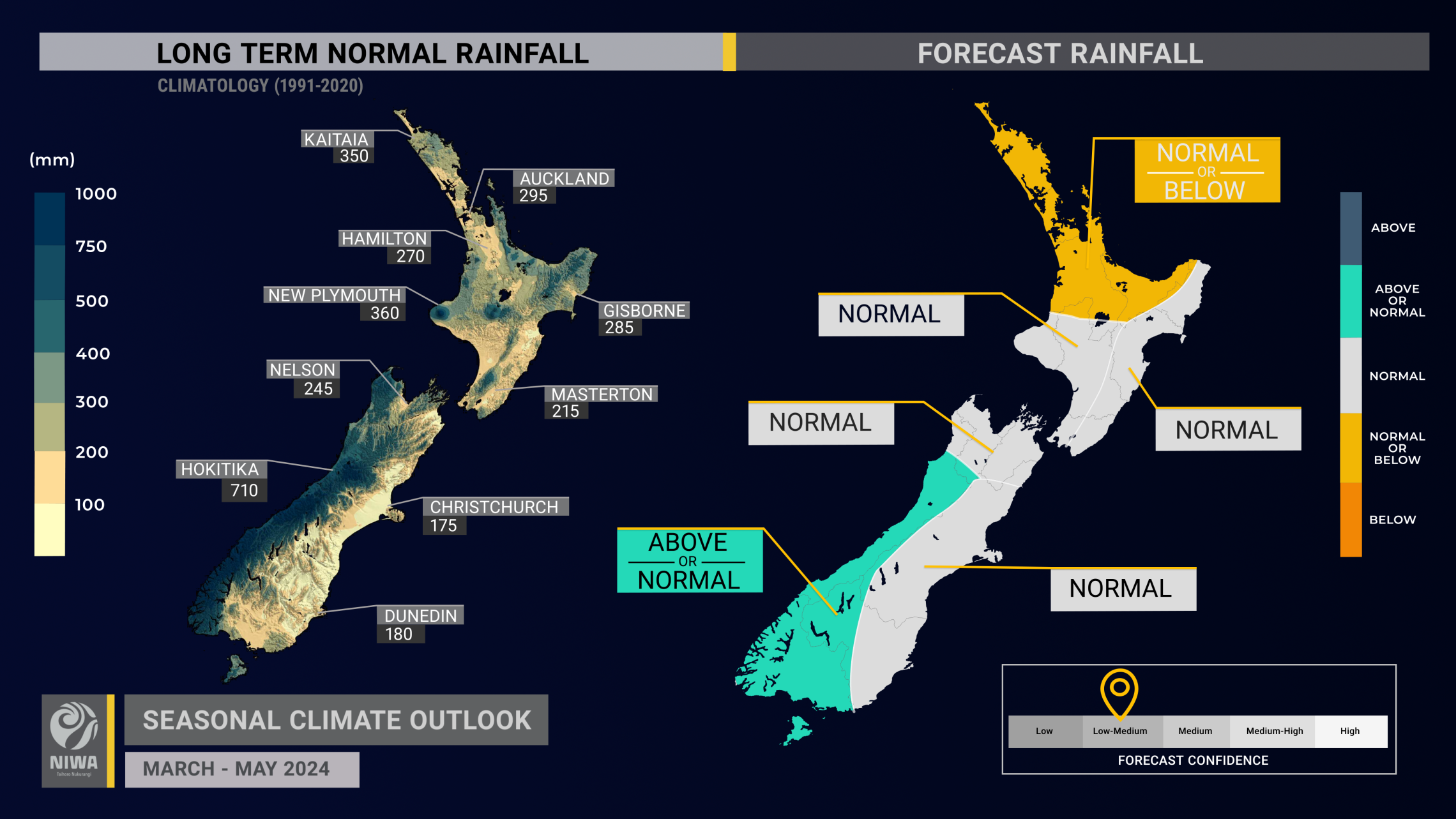
Regional predictions for March – May 2024
The tables below show the probabilities (or percent chances) for each of three categories: above average, near average, and below average. In the absence of any forecast guidance there would be an equal likelihood (33% chance) of the outcome for any of the three categories. Forecast information from local and global guidance models is used to indicate the deviation from equal chance that is expected for the coming three-month period. All outlooks are for the three months as a whole. There will inevitably be relatively wet and dry days, and hot and cold days, within a season. The exact range in temperature and rainfall within each of the three categories varies with location and season. However, as a guide, the “near average” or middle category for the temperature predictions includes deviations up to ±0.5°C for the long-term mean, whereas for rainfall the “near normal” category lies between 80 per cent and 120 per cent of the long-term (1991-2020) mean.
Northland, Auckland, Waikato, Bay of Plenty
- Temperatures are most likely to be above average (55% chance). High pressure systems in late March and April will likely cause cool mornings but warmer afternoons.
- Rainfall totals are about equally likely to be near normal (40% chance) or below normal (35% chance). The first week and second half of March will come with elevated chances for heavy rainfall in the region, though drier conditions may return from late March into April.
- Soil moisture levels are most likely to be below normal (50% chance) while river flows are about equally likely to be near normal (40% chance) or below normal (45% chance).
| Temperature | Rainfall | Soil moisture | River flows | |
| Above average | 55 | 25 | 10 | 15 |
| Near average | 40 | 40 | 40 | 40 |
| Below average | 05 | 35 | 50 | 45 |
Central North Island, Taranaki, Whanganui, Manawatu, Wellington
Probabilities are assigned in three categories: above average, near average, and below average.
- Temperatures are equally likely to be near average or above average (45% chance each).
- Rainfall totals are most likely to be near normal (40% chance). The first week and second half of March will bring an opportunity for rainfall, some heavy, in the region. More frequent northwesterly winds may increase the chance for rainfall events through the season.
- Wind speeds are expected to be stronger than normal.
- Soil moisture levels and river flows are about equally likely to be below normal (40-45% chance) or near normal (40-45% chance).
| Temperature | Rainfall | Soil moisture | River flows | |
| Above average | 45 | 30 | 15 | 15 |
| Near average | 45 | 40 | 45 | 40 |
| Below average | 10 | 30 | 40 | 45 |
Gisborne, Hawke’s Bay, Wairarapa
Probabilities are assigned in three categories: above average, near average, and below average.
- Temperatures are most likely to be above average (55% chance). Although a cool spell is expected in early-to-mid March, more northwest winds through the season will elevate the odds of above average temperatures.
- Rainfall totals are most likely to be near normal (45% chance). The first week (for inland areas) and second half of March will come with elevated chances for rain in the region, though drier conditions may return toward the end of the month into April.
- Wind speeds are expected to be stronger than normal.
- Soil moisture levels and river flows are about equally likely to be near normal (40% chance) or below normal (45% chance).
| Temperature | Rainfall | Soil moisture | River flows | |
| Above average | 55 | 25 | 15 | 15 |
| Near average | 40 | 45 | 40 | 40 |
| Below average | 05 | 30 | 45 | 45 |
Tasman, Nelson, Marlborough, Buller
Probabilities are assigned in three categories: above average, near average, and below average.
- Temperatures are about equally likely to be above average (45% chance) or near average (40% chance).
- Rainfall totals are most likely to be near normal (45% chance). While the first week of March will come with some rain for the driest areas, it won’t be enough to ease long-term soil moisture deficits. Another chance for rain will come in the second half of the month, likely followed by drier conditions in eastern areas from late March into April.
- Wind speeds are expected to be stronger than normal.
- Soil moisture levels are most likely to be below normal (50% chance) while river flows are equally likely to be near normal or below normal (45% chance each).
| Temperature | Rainfall | Soil moisture | River flows | |
| Above average | 45 | 25 | 10 | 10 |
| Near average | 40 | 45 | 40 | 45 |
| Below average | 15 | 30 | 50 | 45 |
West Coast, Southern Alps and foothills, inland Otago, Southland
Probabilities are assigned in three categories: above average, near average, and below average.
- Temperatures are about equally likely to be above average (45% chance) or near average (40% chance).
- Rainfall totals are equally likely to be near normal (40% chance) or above normal (40% chance). Occasional strong fronts, lows, atmospheric rivers, and more frequent northwesterly winds may bring heavy rainfall, such as in early March.
- Wind speeds are expected to be stronger than normal.
- Soil moisture levels are most likely to be near normal (45% chance) while river flows are equally likely to be near normal or above normal (40% chance each).
| Temperature | Rainfall | Soil moisture | River flows | |
| Above average | 45 | 40 | 35 | 40 |
| Near average | 40 | 40 | 45 | 40 |
| Below average | 15 | 20 | 20 | 20 |
Coastal Canterbury and the nearby plains, east Otago
Probabilities are assigned in three categories: above average, near average, and below average.
- Temperatures are most likely to be above average (55% chance). Although a cool spell is expected in early-to-mid March, more northwest winds through the season will elevate the odds of above average temperatures.
- Rainfall totals are most likely to be near normal (45% chance). The first week (for inland areas) and second half of March will come with elevated chances for rain in the region, though drier conditions may return from late March into April.
- Wind speeds are expected to be stronger than normal.
- Soil moisture levels and river flows are most likely to be below normal (50% chance).
The full probability breakdown is:
| Temperature | Rainfall | Soil moisture | River flows | |
| Above average | 50 | 25 | 10 | 15 |
| Near average | 40 | 45 | 40 | 35 |
| Below average | 10 | 30 | 50 | 50 |
Graphical representation of the regional probabilities
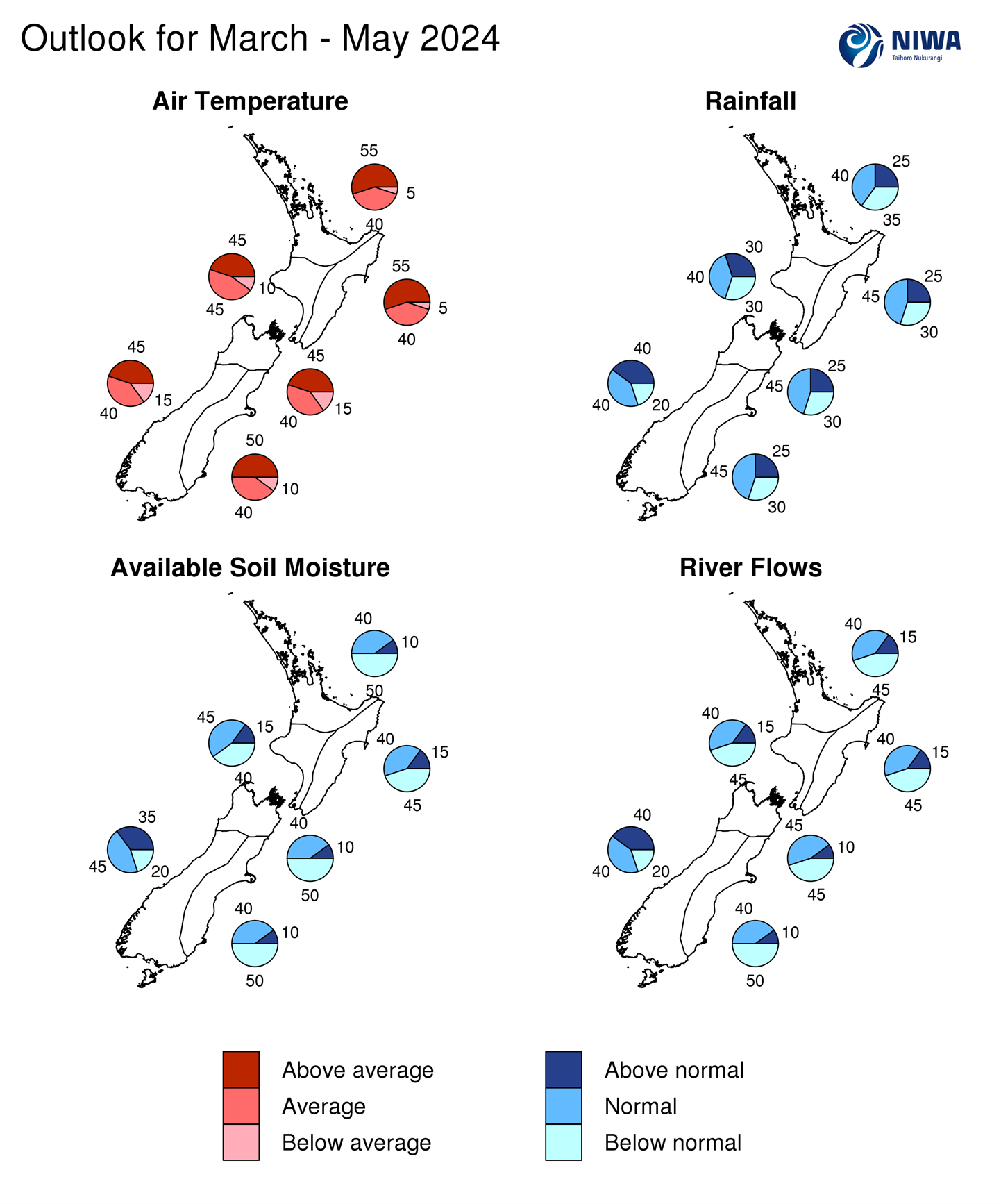
Background
TheNINO3.4 Index anomaly (which covers the west-central equatorial Pacific) over the last month (through 27 February 2024) was +1.58˚C, within the range of a strong El Niño (classified when the NINO3.4 Index is greater than +1.5˚C).
The Southern Oscillation Index (SOI) was in the El Niño range during February (-1.2) and neutral during December-February (-0.4). This suggests that El Niño’s reflection in the atmosphere has been atypical, particularly considering the oceanic intensity.
The El Niño event is past its peak oceanic intensity and is likely to weaken further during March.
Of the models monitored by NIWA, ENSO neutral conditions are favoured to develop by the start of winter. La Niña conditions are then favoured to develop between July and September, owing to a significant area of cooler than average sea water just below the surface in the equatorial Pacific.
Trade wind strengthwas slightly below normal across most of the equatorial Pacific during February and greatly reduced from normal in the off-equatorial South Pacific, where winds blew from the west. This westerly wind anomaly may have assisted with the eastward progression of a sub-surface cool pool. During March, an area of enhanced trade winds is forecast around the International Date Line, a reversal of February’s pattern and the one that dominated over recent months.
At the end of February, the subsurface equatorial Pacific was cooler than average below 100 m depth across most of the basin. Above average temperatures were confined to the upper 50-100 m. Upper-oceanic heat content returned to near normal values in the equatorial Pacific aside from the far eastern part of the Pacific, suggesting that ‘cool pool’ of sub-surface water had significantly eroded warmth associated with El Niño.
During February,convective forcing favoured the central and eastern Pacific with subsidence over the Maritime Continent and western Pacific, strongly aligned with El Niño conditions. It marked an important change compared to previous months where convective forcing favoured the area around the International Date Line. As a result, New Zealand’s weather patterns over the last month were more typical of El Niño.
As of late February, the Madden-Julian Oscillation (MJO) was active over Africa and the western Indian Ocean. During early March, the pulse is forecast to propagate across the eastern Indian Ocean, Maritime Continent, and into the Pacific Ocean.
Phases 3-6 have historically favoured wetter than normal conditions in the North Island, and occasionally the South Island. Toward mid-March, this could result in an easing of abnormal dryness in several regions with moist, northeasterly winds at times – a pattern going against the grain of El Niño. Temperature-wise, after an early month cold spell, a warming trend is anticipated, which is aligned with phases 4-6, particularly away from the east coast.
Late in March and into April, the MJO looks likely to migrate into the eastern Pacific and Africa, which may result in a return to westerlies and dryness in northern and eastern areas of both islands. High pressure could be a key climatic feature for New Zealand during April, particularly if the MJO spends a meaningful amount of time in the Indian Ocean.
Critically, a cell of sinking air is forecast to strengthen in the western Pacific to the north of New Zealand during April and May, which would reduce tropical moisture availability to the country during mid and late autumn.
Climate-sensitive sectors are encouraged to make use of the New Zealand drought dashboard, which provides 35-day outlooks of rainfall and drought, updated once daily: https://niwa.co.nz/climate/seasonal-climate-outlook
The Southern Annular Mode (SAM) was positive for most of February. The SAM may turn neutral in early March with a strong signal for low pressure, followed by a return to more positive values and higher than normal air pressure around New Zealand. The SAM may become negative later in the month as a low pressure signal emerges again.
Marine heatwave conditions became much less widespread during February and were confined to the northern and eastern North Island at the end of the month. This owes to stronger than normal winds, which encouraged ocean mixing, particularly near the South Island.
For more info, see the NIWA Sea Surface Temperature Update.
NZ 30-day coastal SST anomalies (to 27 February)
| North NI | +0.63˚C |
| West NI | +0.17˚C |
| East NI | +0.57˚C |
| North SI | -0.22˚C |
| West SI | -0.32˚C |
| East SI | +0.46˚C |
